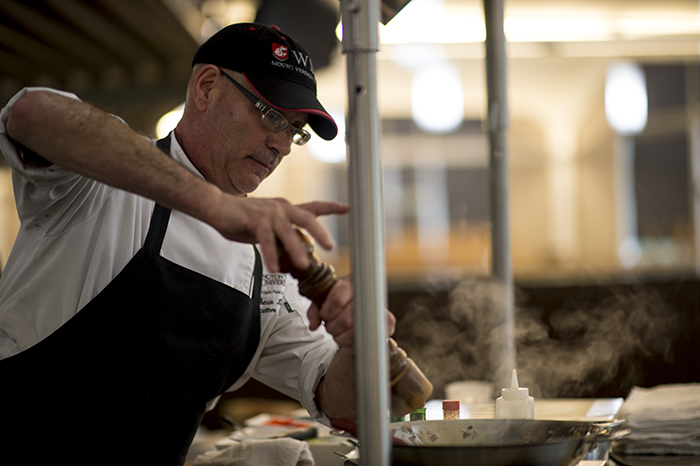Chefs prepare and serve plant-based meals during workshop
LUKE HOLLISTER | The Daily Evergreen
Dining Services Chef Matthew Lasof cooks cajun-spiced roasted spring vegetables during a plant-based cooking demonstration Wednesday at Southside Dining Hall
May 22, 2017
Now that WSU is becoming more focused on plant-based cooking and incorporating it into the dining halls, the rest of the WSU community who aren’t freshmen living off of RDA might want to see what their options are.
At the networking event WSU hosted last Wednesday with Forward Food, the food and nutrition advocacy partner with the National Humane Society of the United States, a completely vegan breakfast and lunch was served, along with a cooking demonstration.
And your girl was there to document it all and give you the down low about plant-based cooking. Here’s the big secret: It’s easy! With a few simple substitutions of course. You know, like not using dead animals.
The lunch menu consisted of mushroom and tempeh gumbo with Cajun spiced roasted spring vegetables. For those of you who don’t know what tempeh is don’t feel left out, I didn’t either until I googled it.
Apparently, tempeh is a soy product that is nothing like tofu. It has a nuttier flavor, perhaps due to the fact the soy beans are slightly fermented before being beat into a patty. It is high in protein and calcium, and low in fat.
Muffaletta was also served, which is basically the world’s fanciest name for a sandwich. The bread is a soft sesame bread, and while usually made with meats, cheese and olive salad, this variation featured eggplant, roasted red pepper, olive, banana pepper and avocado.
For dessert, bananas foster was served. I also didn’t know what a foster is and still don’t, because I definitely thought it was pie.
Food professionals who attended the event were treated a step by step demonstration of how the food was cooked, namely, the Cajun spiced vegetables.
Matthew Lasof, executive chef from WSU Dining Services, started off with the New Orleans blackened cauliflower. Normally this recipe uses redfish, but to make it vegan, cauliflower was used.
Lasof treated the cauliflower basically like a hunk of meat. He cut the end off, sliced it in half and seared it with soy butter. Then he added a pretty basic blackening seasoning — paprika, onion powder, garlic powder, thyme, black pepper, cayenne pepper, oregano and basil. You know, basic.
The key to cooking with plants, according to Lasof, is to build flavor. When making black eyed peas — the food, not the band featuring the one and only Fergie — he sautéed the onions until fragrant, added tomatoes, celery and garlic and added spice to pull the flavor out. Hot sauce was also used, because it adds a little bit of heat and the vinegar helps to enhance the flavor.
If you really, really just can’t give up meat, dairy and eggs, I hear you. That’s why I highly encourage you to cheat a bit and become a flexitarian. Designate one day, or a few, days of the week to eat entirely vegan or vegetarian, it’s up to you. What matters is that even that one day can help reduce the environmental impacts large scale meat production creates.
And hell, if you can’t make a whole meal vegan or vegetarian, just bake vegan. There’s this really cool thing called aquafaba, which is straight up bean juice. You know, the liquid you’ve been pouring down the sink your entire life? Turns out it’s a great binder and substitute for eggs in baking.
So there you have it. Without egg, most baked goods become vegan. Use vegetables like cauliflower and eggplant, and with the right spices, you might not even notice the meat is gone. Plant-based cooking: it’s easy, it’s fun, and it’s good for the environment and saves the animals.





















